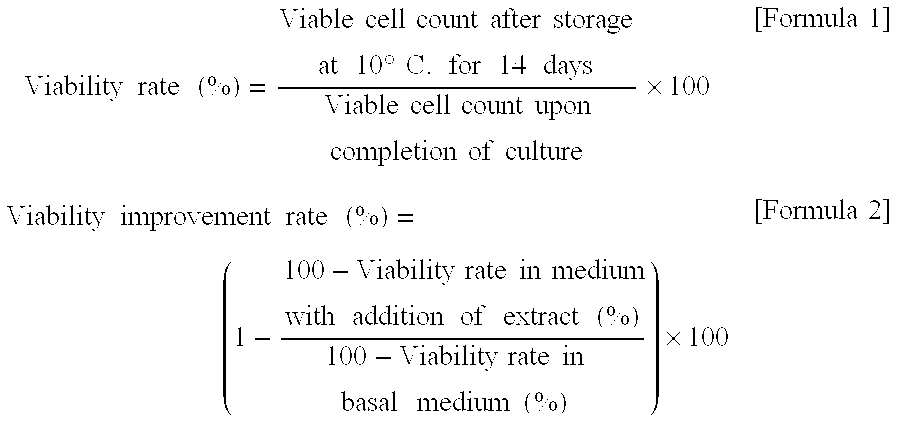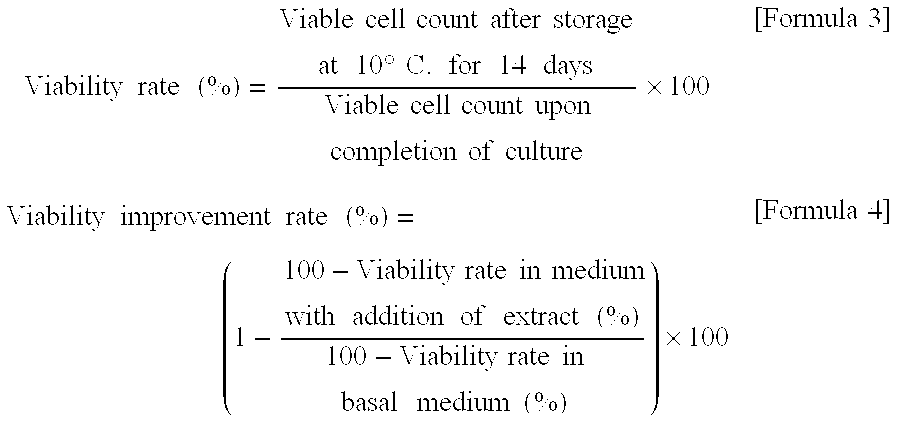Fermented food containing bifidobacterium bacteria and method for producing the same
a technology of fermented food and bacteria, which is applied in the field of fermented food containing bifidobacterium bacteria, can solve the problems of poor viability, limited usability of containers, and rapid death, and achieve excellent viability-improving effects, no effect on flavor, and improved viability of bacteria
- Summary
- Abstract
- Description
- Claims
- Application Information
AI Technical Summary
Benefits of technology
Problems solved by technology
Method used
Image
Examples
example 1
Extract Preparation 1
[0043]Turmeric (the rootstock of Curcuma longa L.), the aerial grass part of Houttuynia cordata Thunb., leaves of Eucommia ulmoides Oliv., rice bran (a mixture of perocarps, aleurone layers and germs of kernels (brown rice) available from Oryza Sative without the chaff paddy), persimmon leaves (leaves of Diospyros kaki Thunb.), leaves of Perilla frutescens (L.) Britton var. acuta Kudo, clove (the bud of Syzygium aromaticum (L.) Merr. et Perry) and cinnamon (the bark of Cinnamomum zeylanium Nees) were each separately subjected to processings such as peeling and crushing, and then extracted for 60 minutes with hot water of 90° C. (in an amount 10 times as much as the weight of the corresponding raw material) to prepare extracts of turmeric, Houttuynia cordata Thunb., rice bran, Eucommia ulmoides Oliv., persimmon leaves, perilla, clove and cinnamon, respectively. The extracts were each separately concentrated to 10 degrees Brix in an evaporator.
example 2
Comparison in the Viability of Bacteria of the Genus Bifidobacterium
[0044]As a basal medium, 12% skim milk powder solution was furnished. The extracts of turmeric, Houttuynia cordata Thunb., Eucommia ulmoides Oliv., rice bran, persimmon leaves, perilla, clove and cinnamon, which had been prepared and adjusted to 10 degrees Brix in Example 1, were added at 1% to aliquots of the basal medium, respectively, followed by sterilization to prepare sterilized media. To each of those media, a starter of Bifidobacterium breve strain was inoculated at 1%, and the bacteria strain was cultured at 37° C. until the pH reached about 4.8.
[0045]The viable cell count of the bacteria in each medium was determined upon completion of culture and after storage at 10° C. for 14 days using TOS medium (product of Yakult Pharmaceutical Ind. Co., Ltd.). Based on the viable cell count thus determined, the viability rate of the bacteria of Bifidobacterium was calculated according to the following formula 1. Fur...
example 3
Verification of Effects of Acid Extraction Extract on Viability-Improving Effects for Bacteria of the Genus Bifidobacterium
[0047]Under similar conditions as in the extract preparation in Example 1 except for the use of water and aqueous solutions, the pHs of which had been adjusted to 3.0, 4.0 and 5.0, respectively, with citric acid instead of hot water, persimmon leaves were treated. To aliquots of a 12% skim milk powder medium, to which the thus-obtained extracts had been added at 1%, respectively, the starter of Bifidobacterium breve YIT10001 was inoculated at 1%. The bacteria strain was then cultured at 37° C. until the pH reached about 4.8. The viable cell count of the bacteria in each medium was determined upon completion of culture and after storage of the culture at 10° C. for 14 days in a similar manner as in Example 2. The viability rate and the viability improvement rate were respectively calculated in the same manner as in Example 2. The results are shown below in Table...
PUM
 Login to View More
Login to View More Abstract
Description
Claims
Application Information
 Login to View More
Login to View More - R&D
- Intellectual Property
- Life Sciences
- Materials
- Tech Scout
- Unparalleled Data Quality
- Higher Quality Content
- 60% Fewer Hallucinations
Browse by: Latest US Patents, China's latest patents, Technical Efficacy Thesaurus, Application Domain, Technology Topic, Popular Technical Reports.
© 2025 PatSnap. All rights reserved.Legal|Privacy policy|Modern Slavery Act Transparency Statement|Sitemap|About US| Contact US: help@patsnap.com


